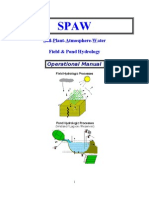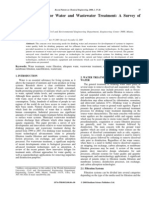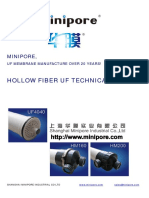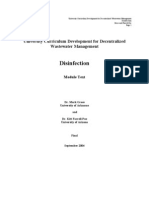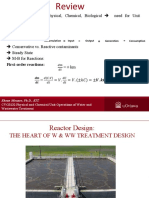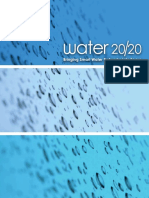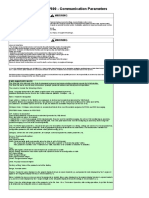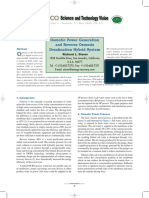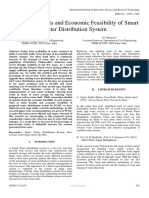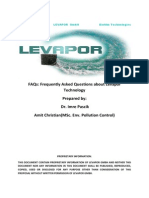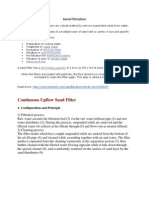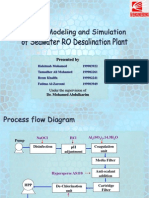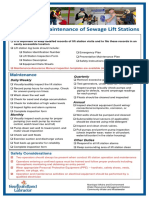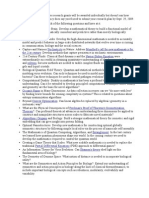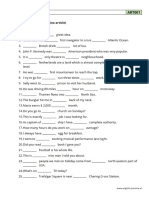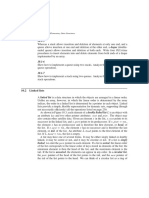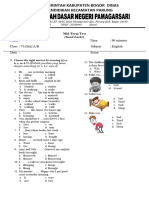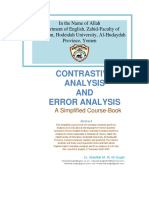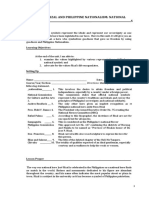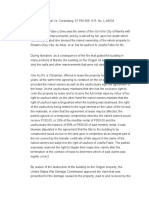Merrill First Principles
Uploaded by
J GMerrill First Principles
Uploaded by
J GFirst Principles
Running head: First Principles of Instruction
First Principles of Instruction: A synthesis
M David Merrill
Utah State University
First Principles
Abstract
A set of interrelated principles for instructional design are identified and listed as questions to
ask about an instructional product. Following each question are instructional principles that have
been identified and stated by other authors. These principles support and in some cases elaborate
the principles that have been identified. Each of the principles included in this synthesis has
been supported by empirical research which is described in the source from which the principle
has been quoted. It is believed that there is a direct correlation between the effectiveness of an
instructional product and the degree to which the product implements these first principles of
instruction.
First Principles
First Principles of Instruction: A synthesis
Recent years have seen a proliferation of instructional design theories and models.
Instructional design theory varies from basic descriptive laws about learning to broad curriculum
programs that concentrate on what is taught rather than on how to teach. Are all of these design
theories and models merely alternative ways to approach design? Do all of these design theories
and models have equal value? Do these design theories and models have fundamental
underlying principles in common? If so what are these underlying first principles? Previously
(Merrill, 2002a) I outlined a set of first principles for instructional design derived from a study of
a number of different instructional design theories and models. It was concluded that these
different theories and models do share common principles and that they do not incorporate
fundamentally different principles. No theory or model previously reviewed includes principles
that are contrary to those identified.
The identification of first principles does more than merely collect a set of prescriptive
principles that might be used to select or design effective instruction. These principles are
interrelated to one another. A four phase cycle of instruction was identified (see Figure 1)
consisting of activation, demonstration, application, and integration. Effective instruction
involves all four of these activities repeated as required for different problems or whole tasks.
Learning is facilitated when the first activity in a learning cycle activates relevant prior
knowledge. Learning is facilitated when the instruction directs learners to recall, relate, describe
or apply knowledge from relevant past experience that can be used as a foundation for the new
knowledge. If learners have limited prior experience, learning is facilitated when the instruction
provided relevant experience that can be used as a foundation for the new knowledge.
First Principles
Learning is facilitated when the next activity in a learning cycle demonstrates the new
knowledge to be learned rather than merely telling information about what is to be learned. Too
much instruction merely tells information. Information is usually general, abstract and refers to
many specific situations. Learning is facilitated when instruction also shows portrayals of the
information. Portrayals are representations of a specific cases that are concrete and that illustrate
how the information applys to a single situation.
Learning is facilitated when the third activity in a learning cycle provides opportunity for
the learner to apply the new knowledge to new specific situations. Application involves more
than merely remembering information; it requires the learner to use the information to complete
specific concrete tasks or to solve specific problems. Application involves solving whole
problems or doing whole tasks and is more than merely answering questions about one step, one
action or one event in the whole.
Finally a learning cycle is completed when learners have an opportunity to integrate the
new knowledge and skill into their everyday activities. Learning is facilitated when the
instruction provides an opportunity to publicly demonstrate their newly acquired knowledge and
skill, when the instruction provides an opportunity to reflect on, discuss, or defend their new
knowledge, and when the instruction provides an opportunity for the learners to creat, invent or
explore new and personal ways to use their new knowledge and skill.
Perhaps as important as the 4-phase cycle of instruction is the notion that effective
instruction is problem-centered, that is individual instructional components are most effectively
taught in the context of a progression of real-world problems where the student is shown a
problem, then taught the components, and then shown how the components are used to solve the
problem or do the whole task. The Pebble-in-the-Pond approach to instructional design (Merrill,
First Principles
2002b) prescribes worked problems early in the sequence of instruction and a gradual fading of
this guidance or coaching as the instruction proceeds. Figure 2 illustrates this problem
progression components instructional strategy.
First principles prescribes a problem-centered approach that combines the solving of
problems with more direct instruction of problem components as contrasted with problem-based
approaches in which students are placed in collaborative groups, given resources and a problem,
and left to construct their own solution for the problem.
Most tasks or problems are complex aggregations of individual instructional components.
Learning is facilitated when these components are directly taught in the context of a progression
of whole problems or tasks. Too much instruction teaches the individual components or topics
and leaves their integration to the student. Too often after a series of topics or components are
taught the student is given a single task as a culminating experience and asked to use these
components to solve the problem or complete the task. These typical topic-centered approaches
are far less effective than an integrated approach that combines problem-centered instruction
with direct instruction of the individual components.
While a number of different schemes for identifying instructional components have been
proposed most include the following categories. The terms used here are more easily understood
by subject matter experts than some of the more technical terms used by other schemes.
Nevertheless, these simplified terms correspond sufficiently with previous knowledge
classification schemes to allow specification of different demonstration and application
conditions for each type of instructional component.
Most tasks or problems include the following instructional components: informationabout, parts-of, kinds-of, how-to, and what-happens. Each of these components has a general
First Principles
information element and one or more specific portrayal elements. The information and portrayal
elements for each component category is indicated in the following table:
Learning outcome
Tell Information
Show Portrayal
information-about
facts or associations
not applicable
parts-of
name and description
___location
kinds-of
definition
examples and non-examples
how-to
steps and sequence
illustration of steps for a
specific cases
what-happens
describe process,
illustration of specific
conditions, consequences
conditions and consequences
for specific cases
The demonstration and application applied to individual instructional components is not
effective unless the information and portrayals involved are consistent with the type of
component. Consistency means that the information and portrayals used correspond to the type
of instructional component being taught. Consistency has been extensively described by Gagne
(1985) and Merrill (1994).
In this paper I have attempted to gather empirically-verified prescriptive principles from
several recent works and relate them to the outline of first principles. Rather than theories or
models of instruction, as in my first paper, I selected sources that cited the research support for
the prescriptive principles that we have cited here. As in the first review not all of these works
include all of the principles. If a given heading contains no principles from the works we
reviewed then it is because the source did not include a principle in this category in their list.
None of these sources contained any contrary principles. Some of the principles cited provide
First Principles
more detail than our statement of first principles. The principles were not transformed to
correspond to the first principles but are quoted stated by their author. The reader is encouraged
to study the original source for the principles listed. These sources include a description of the
research support as well as application examples for the principles
In this synthesis the first principles are stated in question form. The reader of the
previous work will note that there have been some modifications in some of the principles from
their original publication. We have also added a section on implementation to include
prescriptions that reviewers of our work have often cited as an omission.
Synthesis of First Principles
Problem-centered (Let me do the whole task!)
Does the instruction involve authentic real-world problems or tasks?
Interactions should mirror the job (p. 53). (R. C. Clark & Mayer, 2003)
Use job contexts to teach problem solving processes (p. 251). (R. C. Clark & Mayer, 2003)
Focus training on thinking processes versus job knowledge (p. 256). (R. C. Clark & Mayer,
2003)
Incorporate job-specific problem-solving processes (p. 264). (R. C. Clark & Mayer, 2003)
In place of a formal objective, does the instruction show the learners the whole task
they will be able to do or the whole problem they will be able to solve as a result of
completing the instruction?
When instruction provides clear (to the learner) and complete procedural how to examples of
the decisions and actions needed to solve problems and perform necessary tasks to be learned, then
learning and transfer will be increased (p. 16). (R. E. Clark, 2003)
Instructional goals narrow what students focus on (p. 94). (Marzano, Pickering, & Pollock,
2001) Note this is probably because most objectives are component or topic oriented rather than
whole task or whole problem oriented.
Instructional goals should not be too specific (p. 94). (Marzano et al., 2001) Note that when
objectives are very specific they are usually topic-oriented rather than whole task oriented.
Sometimes objectives are specific to only one instance of a task rather than to a class of tasks.
Begin a lesson with a short statement of goals. (Rosenshine, 1997) Note this is the classic
prescription. Rosenshine cites research showing goals are better than no goals. Clarks research
shows that illustrating the task is better than formal objectives.
Does the instruction teach the components of the problem or task and then help the
learner use these components in solving the whole problem or doing the whole task?
(See Figure 2 Instructional Sequence.)
Students should practice the parts of a process in the context of the overall process (p. 142).
(Marzano et al., 2001)
First Principles
Present new material in small steps, providing for student practice after each step. (Rosenshine,
1997). Note Rosenshine stresses teaching components is better than not teaching components but
Marzanos findings indicate that it is still better when this component instruction is related to the
whole task.
Does the instruction involve a progression of problems not just a single application?
Use job-realistic or varied worked examples (p. 186). (R. C. Clark & Mayer, 2003) Note that
the emphasis here is on a varied sequence of job-related tasks rather than on a single task.
Activation (Where do I start?)
Does the instruction direct learners to recall, relate, describe or apply prior knowledge
from relevant past experience that can be used as a foundation for the new
knowledge? If learners have limited prior experience, does the instruction provide
relevant experience that can be used as a foundation for the new knowledge?
Cues and questions are ways that a teacher helps students use what they already know about a
topic. Cues and questions should focus on what is important as opposed to what is unusual.
Higher level questions produce deeper learning than lower level questions. Questions are
effective learning tools even when asked before a learning experience (pp. 112-114). (Marzano
et al., 2001)
providing cues to encourage learners to activate relevant preexisting knowledge facilitates
learning (p. 246). (Andre, 1997)
Help students develop their background knowledge. (Rosenshine, 1997)
Review. relevant previous learning prerequisite skills and knowledge. (Rosenshine, 1997)
Does the instruction help learners see its relevance and to have confidence in their
ability to acquire the knowledge and skill to be taught?
Designers can help students to become actively engaged in a course or lesson and to persist or
stay on track when distracted by helping students connect their personal goals and interests to
course goals, by clearly communicating the utility of the course goals (and the risk of not
achieving them), and by helping students maintain their confidence in achieving the course goals
(by pointing out past successes with similar goals) (p. 20). (R. E. Clark, 2003)
simply demonstrating that added effort will pay off in terms of enhanced achievement actually
increases student achievement (p. 51). (Marzano et al., 2001)
Students should be encouraged to personalize the teachers goals (p.94). (Marzano et al., 2001)
Does the instruction provide or encourage the recall of a structure that can be used to
organize the new knowledge?
Representing similarities and differences in graphic or symbolic form enhances students
understanding of and ability to use knowledge (p. 16). (Marzano et al., 2001)
Being aware of the explicit structure of information is an aid to summarizing information (p. 32).
(Marzano et al., 2001)
Graphic organizers are perhaps the most common way to help students generate nonlinguistic
representations (p. 75). The more we use both systems of representation linguistic and
nonlinguistic the better [learners] are able to think about and recall knowledge (p. 73).
(Marzano et al., 2001)
Advance organizers should focus on what is important as opposed to what is unusual. Higher
level advance organizers produce deeper learning than the lower level advance organizers.
Advance organizers are most useful with information that is not well organized (p. 118).
First Principles
(Marzano et al., 2001) concrete AOs [advance organizers] seem to be more effective than
more abstract AOs (p. .248). (Andre, 1997)
Providing learners with a conceptual model can facilitate the acquisition of problem-solving
skills (p. 247) (Andre, 1997)
providing students with appropriate maps and diagrams has been shown to enhance their
learning. Concept or semantic mapping has promise of helping students acquire the
interrelationships component of a knowledge ___domain (p. 253). (Andre, 1997)
Provide and Teach a Checklist. (Rosenshine, 1997)
Demonstration (Dont just tell me, show me!)
Does the instruction demonstrate (show examples of) what is to be learned rather than
merely telling information about what is to be learned?
Replace some practice problems with worked examples (p. 177) . (R. C. Clark & Mayer, 2003)
examples in teaching concepts, principles, and problem-solving procedures [result in]
substantial benefits. presenting learners with worked-out examples led to more effective
learning(p. 255) (Andre, 1997)
Are the demonstrations (examples) consistent with the content being taught?
Are there examples and non-examples for kinds-of (concepts)?
New concepts should be taught by providing a definition of the concept, examples from the work
environment, and practice exercises in which learners are asked to correctly classify many
different work-relevant concept examples. If new concepts are presented with these supports,
learning of concepts is enhanced. If highly novel applications of the concept are required, then
provide practice on many different novel examples of the concept (p. 24). (R. E. Clark, 2003)
In teaching concepts or classification skills, it is important to provide students with a range of
examples of particu7lar concepts and also to provide contrasts between examples of closely
related concepts (p. 256). (Andre, 1997).
instruction should activate misconceptions and then induce learners to be in a state of
disequilibrium or dissatisfaction about the misconception (p. 257). (Andre, 1997) Note that one
role of nonexamples is to allow a student to see where the information does not apply or where
they may have mistakenly thought it applied when it does not. This principle is an elaboration of
the examples and nonexamples prescription.
When teaching procedures, the more that instruction is based on expert-based descriptions of the
sequence of actions and decisions necessary for goal achievement, and is accompanied by a
worked example and the opportunity for part-whole practice that is scaffolded to reflect the
learners prior knowledge and accompanied by a conceptual elaboration of the declarative
knowledge base supporting the procedure, the more effective will be the learning and transfer of
the procedure back to the job environment (p. 30). (R. E. Clark, 2003)
Are there demonstrations for how-to (procedures)?
Are there visualizations for what-happens (processes)?
When designing instruction for a process (how something works), give students a clear narrative
description integrated with a visual model of the sequence of events that characterize the process,
and describe each stage in the process and what key events or actions occur at each stage to
produce a change that leads to the next stage (p. 26). (R. E. Clark, 2003)
First Principles
10
When teaching causal principles, the more that the instructional presentation provides a statement
about the cause and resulting effects, provides instruction using a worked, prototypical example
drawn from the application setting, and helps the learner to first elaborate the elements and
sequence of the causal chain and then to apply it to gradually more novel and complex examples,
the more effective will be the learning and transfer to the job (p.28). (R. E. Clark, 2003)
Are some of the following learner guidance techniques employed?
Is learners attention is directed to relevant information?
People learn better from narrated animations when the narration highlights the key steps and the
links between them (p. 47). (Mayer, 2003)
Presenting students with explicit guidance in identifying similarities and differences enhances
students understanding of and ability to use knowledge (p. 15). (Marzano et al., 2001)
Asking students to independently identify similarities and differences enhances students
understanding of and ability to use knowledge (p. 15). (Marzano et al., 2001)
use of signaling devices generally has positive effects on memory for the presented
information (p. 255). (Andre, 1997)
Are multiple representations are included and explicitly compared?
Visual representation of text material is helpful in improving comprehension of complex material
(p. 60). (Dembo & Young, 2003)
People learn better from corresponding words and graphics (e.g., animation, video, illustrations,
pictures) than from words alone (p. 51, p. 37). (R. C. Clark & Mayer, 2003; Mayer, 2003)
The more we use both systems of representation linguistic and nonlinguistic [graphic] the
better we are able to think about and recall knowledge (p. 73). (Marzano et al., 2001)
People learn better when corresponding words and graphics are placed near rather than far from
each other on the screen (p. 67, p. 49). (R. C. Clark & Mayer, 2003; Mayer, 2003)
People learn better when corresponding animation and narration segments are presented
simultaneously (p. 51). (Mayer, 2003)
Are learners are assisted to relate the new information to the structure that
was recalled or provided?
Teach learners to self-explain examples (p. 190). (R. C. Clark & Mayer, 2003) Note if this self
explanation assists learners to relate the new information to previously learned information or the
structure that was recalled or provided then it will facilitate learning.
Make learners aware of their problem-solving processes (p. 260). (R. C. Clark & Mayer, 2003)
Note that the processes that facilitate learning are those that help the student relate previous
knowledge to new knowledge or to the structure that was provided.
[Use] a variety of structured tasks to guide students through generating and testing hypotheses (p.
106). (Marzano et al., 2001) Note testing hypotheses is another way to relate specific cases to
general information.
relating to-be-learned instructional events to preexisting knowledge leads to superior
learning and performance (p. 250). (Andre, 1997)
Give clear and detailed instructions and explanations. (Rosenshine, 1997)
Are the media relevant to the content and used to enhance learning?
Present words as speech rather than onscreen text (p. 86). (R. C. Clark & Mayer, 2003)
First Principles
11
People learn better from animation and narration than from animation, narration, and on-screen
text (p. 45). (Mayer, 2003) Avoid presenting words as narration and identical text in the
presence of graphics (p. 99). (R. C. Clark & Mayer, 2003)
People learn better from narrated animations when the narration has a human voice with a
standard accent rather than a machine voice or an accented voice (p. 53). (Mayer, 2003)
People learn better from multimedia messages when extraneous words, pictures, and sounds are
excluded rather than included (p. 33). (Mayer, 2003) Avoid e-Lessons with extraneous sounds,
extraneous pictures, extraneous graphics or extraneous words (pp. 111-126). (R. C.
Clark & Mayer, 2003)
Application (Let me do it!)
Do learners have an opportunity to practice and apply their newly acquired
knowledge or skill?
Critical tasks require more practice (p. 159). (R. C. Clark & Mayer, 2003)
Provide a high level of active practice for all students. (Rosenshine, 1997)
Ask a large number of questions, check for student understanding, and obtain responses from all
students. (Rosenshine, 1997)
Are the application (practice) and assessment (tests) consistent with the stated or
implied objectives?
Does information-about (factual information) practice require learners to
recall or recognize information?
Does parts-of practice require learners to locate, name, and/or describe
each part?
Does kinds-of (concept) practice require learners to identify new examples
of each kind?
Asking students to apply taught concepts to new examples facilitates students acquisition or
construction of the concept (p. 251). (Andre, 1997)
Does how-to (procedure) practice require learners to do the procedure?
Does what-happens (process) practice require learners to predict a
consequence of a process given conditions, or to find faulted conditions
given an unexpected consequence?
Is the practice followed by corrective feedback and an indication of progress not just
right-wrong feedback?
Effective feedback about learning progress results in better learning and transfer of such learning
to the work environment (p. 18). (R. E. Clark, 2003)
Feedback should be corrective in nature. simply telling students that their answer on a test is
right or wrong has a negative effect on achievement. The best feedback appears to involve an
explanation as to what is accurate and what is inaccurate in terms of student responses (p. 96).
(Marzano et al., 2001)
Feedback should be specific to the criterion (p. 98). (Marzano et al., 2001)
Provision of [feedback] typically results in superior performance on later tests than no
[feedback] and providing the correct response is usually more effective than simply saying right or
wrong (p. 259) . (Andre, 1997)
First Principles
12
Provide systematic feedback and corrections. (Rosenshine, 1997)
Does the application or practice enable learners to access context sensitive help or
provide coaching when they are having difficulty in solving the problem or doing the
task? Is coaching gradually diminished with each subsequent task until learners are
performing on-their-own?
Use onscreen coaches to promote learning (p. 138). (R. C. Clark & Mayer, 2003)
Guide students during initial practice. Provide Procedural Prompts or Facilitators Provide
models of appropriate responses Think Aloud as Choices are Being Made. Anticipate and
Discuss Potential Difficulties. Regulate the Difficulty of the Material. Provide a Cue Card.
(Rosenshine, 1997)
When teaching higher-level tasks, support students by providing them with cognitive strategies..
Help students learn to use the cognitive strategies by providing them with procedural prompts
and modeling the use of these procedural prompts. (Rosenshine, 1997)
Increase Student Responsibilities. (Rosenshine, 1997)
Does the instruction require learners to use their new knowledge or skill to solve a
varied sequence of problems or complete a varied sequence of tasks?
Use a variety of structured tasks (p. 106). (Marzano et al., 2001)
Integration (Watch me!)
Does the instruction provide techniques that encourage learners to integrate (transfer)
the new knowledge or skill into their everyday life?
Does the instruction provide an opportunity for the learner to publicly demonstrate
their new knowledge or skill?
Does the instruction provide an opportunity for learners to reflect-on, discuss, and
defend their new knowledge or skill?
The process of explaining their thinking helps students deepen their understanding of the
principles they are applying (p. 105). (Marzano et al., 2001)
Does the instruction provide an opportunity for learners to create, invent, or explore
new and personal ways to use their new knowledge or skill?
Implementation
Does the instruction facilitate learner navigation through the learning task?
Use links sparingly to augment the lesson (p. 239). (R. C. Clark & Mayer, 2003) Note too many
links may lose the learner in hyper space and make it difficult to navigate through the primary
lesson material.
Allow learners to control pacing (p. 240). (R. C. Clark & Mayer, 2003)
Use course maps to provide an overview and orient learners (p. 241). (R. C. Clark & Mayer,
2003)
Provide navigation options on all screens (p. 241). (R. C. Clark & Mayer, 2003)
Make important instructional events the default navigation option (p. 236). (R. C. Clark & Mayer,
2003)
First Principles
13
Is the degree of learner-control appropriate for the learning goals and your learners?
Use learner control for learners with high prior knowledge or high metacognitive skills (p. 234).
(R. C. Clark & Mayer, 2003)
Add advisement to learner control (p. 238). (R. C. Clark & Mayer, 2003)
As the extent of learner control increases, learning decreases except for a very small number of
the most advanced expert learners (p. 14). (R. E. Clark, 2003)
Is collaboration used effectively?
Make assignments that require collaboration among learners (p. 207). (R. C. Clark & Mayer,
2003)
Assign learners to heterogeneous groups (p. 208). (R. C. Clark & Mayer, 2003) Organizing
groups based on ability levels should be done sparingly (p. 87). (Marzano et al., 2001)
Structure group assignments around products or processes (p. 208). (R. C. Clark & Mayer,
2003)
Cooperative groups should be kept rather small [3 or 4 members] in size (p. 88). (Marzano et
al., 2001)
Is the instruction personalized?
People learn better from multimedia lessons when the words are in conversational style rather
than formal style (p. 39). (Mayer, 2003). Use conversational rather than formal style (p. 133).
(R. C. Clark & Mayer, 2003)
The Activation, Guidance, Integration Cycle
The cycle of instruction identified for first principles suggested two layers of relationship.
On the surface first principles identify learning activities that should be included in effective
instruction: activation, demonstration, application and integration. At a deeper level there is
within this cycle a more subtle cycle consisting of a structure guidance coaching reflection
cycle.
In general, research has demonstrated that making students aware of specific structure in
information helps them summarize that information [and subsequently be able to
remember and use this information more effectively] (p. 32) (Marzano et al., 2001).
(Rosenshine, 1997) describes the importance of well-connected knowledge structures.
Asking students to organize information, summarize information or compare new
First Principles
14
material with prior material are all activities that require processing and should help
students develop and strengthen their cognitive structures.
During the activation phase first principles prescribe that students should be encouraged
to recall relevant knowledge or skills, or the instruction should provide an organizing structure
based on what students already know. This structure should then be used to facilitate the
acquisition of the new knowledge. Guidance is often not well defined but it is suggested that one
primary purpose of guidance is to help the student relate the new material to the structure
provided during the activation phase. During the application phase one primary role of coaching
is to help students use this structure to facilitate their application activities. During the
integration phase first principles prescribes reflection. During reflection students should be
guided to summarize what they have learned and again examine how the new knowledge is
related to what they previously knew via the structure that was recalled or provided. It is
interesting to note that many of the courses we have critiqued on the basis of first principles fail
to include activation or integration in any form so the use of guidance or coaching to relate new
material to previously learned material via some structure is therefore not included. This deeper
structure guidance coaching reflection cycle as an integrated cycle of instructional events
deserves more study and research.
Conclusion
It would appear from the limited sources quoted in this paper that first principles are not
only common to and prescribed by many instructional design theories and models, but that they
are also consistent with empirical research on instruction. It is hoped that as instructional design
matures that this set of first principles can form a foundation on which future instructional design
models and prescriptions can build. These principles are deliberately general and their
First Principles
15
implementation can take many forms. These principles do not require the adoption of any
particular philosophical ism. First principles can be found in some form in almost all
instructional design theories and models. We have not identified any principles that are contrary
to these first principles. And yet, with this general agreement on fundamental foundational
principles of instruction, many of the instructional products we have reviewed fail to implement
even the first level of these principles, i.e., these products often fail to provide sufficient
demonstration of worked examples, often fail to provide appropriate practice beyond rememberwhat-you-were-told questions, and seldom are centered in real-world problems. Few
instructional products implement the activation and integration phases. Even fewer instructional
products implement the next level of first principles by providing demonstrations and practice
that are consistent with a variety of different instructional outcomes. Almost none of the
products we have reviewed involve a structure-guidance-coaching-reflection cycle. If these are
the first principles of instruction lets hope that they will become more widely applied thereby
resulting in instruction that is more effective, efficient and appealing.
First Principles
16
Study Guide for First Principles of Instruction
For an overview of First Principles of Instruction:
Merrill, M. David (2002). First principles of instruction. Educational Technology Research and
Development. 50(3), 43-59.
Merrill, M. David (2002). A pebble-in-the-pond model for instructional design. Performance
Improvement. 41(7), 39-44.
McCarthy, Bernice (1996). About Learning. Barrrington, IL: Excel, Inc.
The following text is perhaps the best advanced presentation of an instructional design model
consistent with First Principles of Instruction:
van Merrinboer, Jeroen J. G. (1997). Training Complex Cognitive Skills: A Four-Component
Instructional Design Model for Technical Training. Englewood Cliffs, NJ: Educational
Technology Publications.
References
Andre, T. (1997). Selected Microinstructional Methods to Facilitate Knowledge Construction:
Implications for Instructional Design. In R. D. Tennyson, F. Schott, N. Seel & S. Dijkstra
(Eds.), Instructional Design: International Perspective (Vol. 1, pp. 243-267). Mahwah
NJ:: Lawrence Erlbaum Associates.
Clark, R. C., & Mayer, R. E. (2003). E-Learning and the Science of Instruction. San Francisco:
Jossey-Bass Pfeiffer.
Clark, R. E. (2003). What Works in Distance Learning: Instructional Strategies. In H. F. O'Neil
(Ed.), What Works In Distance Learning (pp. 13-31). Los Angeles: Center for the Study
of Evaluation.
Dembo, M., & Young, L. G. (2003). What works in distance education: learning strategies. In
H. F. O'Neil (Ed.), What Works in Distance Education. Los Angeles: Center for the Study
of Evaluation.
Gagne, R. M. (1985). The Conditions of Learning and Theory of Instruction (4th ed.). New
York`: Holt, Rinehart and Winston.
Marzano, R. J., Pickering, D. J., & Pollock, J. E. (2001). Classroom Instruction that Works:
Research-based Strategies for Increasing Student Achievement. Alexandria, VA:
Association for Supervision and Curriculum Development.
Mayer, R. E. (2003). What Works in Distance Learning: Multimedia. In H. F. O'Neil (Ed.),
What Works in Distance Learning. Los Angeles: Center for the Study of Evaluation.
Merrill, M. D. (1994). Instructional Design Theory. Englewood Cliffs, NJ: Educational
Technology Publications.
Merrill, M. D. (2002a). First principles of instruction. Educational Technology Research and
Development, 50(3), 43-59.
First Principles
17
Merrill, M. D. (2002b). A pebble-in-the-pond model for instructional design. Performance
Improvement, 41(7), 39-44.
Rosenshine, B. (1997). Advances in research on instruction. In E. J. Lloyd, E. J. Kameanui & D.
Chard (Eds.), Issues in Educating Students with Disabilities (pp. 197-221). Mahwah, NJ:
Lawrence Erlbaum.
INTEGRATION
ACTIVATION
PROBLEM
APPLICATION
DEMONSTRATION
Figure 1 Phases of Effective Instruction
Figure 2 Instructional Sequence
You might also like
- Baba Ifa Karade - The Handbook of Yoruba Religious Concepts100% (3)Baba Ifa Karade - The Handbook of Yoruba Religious Concepts142 pages
- Year of The Dragon Chinese Zodiac Forecast 2024No ratings yetYear of The Dragon Chinese Zodiac Forecast 202419 pages
- Drinking Water Treatment Residuals - A Review of Recent UsesNo ratings yetDrinking Water Treatment Residuals - A Review of Recent Uses12 pages
- New Water and Waste Water Treatment SystemNo ratings yetNew Water and Waste Water Treatment System10 pages
- Settlement and Stresses Multi Layer SoilNo ratings yetSettlement and Stresses Multi Layer Soil35 pages
- Greywater Reuse System For Toilet FlushingNo ratings yetGreywater Reuse System For Toilet Flushing10 pages
- Giz Grey Water Recycling and Reuse 2011No ratings yetGiz Grey Water Recycling and Reuse 201194 pages
- Presentasi First Principles of Instructional by M David MerrilNo ratings yetPresentasi First Principles of Instructional by M David Merril20 pages
- Sewage Sludge Management in A Circular Economy Exploring Technologies Applied in NetherlandsNo ratings yetSewage Sludge Management in A Circular Economy Exploring Technologies Applied in Netherlands11 pages
- Disinfection: University Curriculum Development For Decentralized Wastewater ManagementNo ratings yetDisinfection: University Curriculum Development For Decentralized Wastewater Management35 pages
- Decentralized Approaches To Wastewater TreatmentNo ratings yetDecentralized Approaches To Wastewater Treatment8 pages
- Chapter 4A Characteristics and Systems Characteristics and SystemsNo ratings yetChapter 4A Characteristics and Systems Characteristics and Systems31 pages
- CVG 3132-Lecture 3-1 Reactor Design PDFNo ratings yetCVG 3132-Lecture 3-1 Reactor Design PDF29 pages
- Sensus - Water2020-Usweb (See PG 3) PDFNo ratings yetSensus - Water2020-Usweb (See PG 3) PDF40 pages
- ANOVA and Simple Comparative ExperimentNo ratings yetANOVA and Simple Comparative Experiment44 pages
- ATV600 - Communication - Parameters - EAV64332 - V1.3No ratings yetATV600 - Communication - Parameters - EAV64332 - V1.346 pages
- Osmotic Power Generation and Reverse Osmosis Desalination Hybrid SystemNo ratings yetOsmotic Power Generation and Reverse Osmosis Desalination Hybrid System4 pages
- Study On Benefits and Economic Feasibility of Smart Water Distribution System100% (1)Study On Benefits and Economic Feasibility of Smart Water Distribution System6 pages
- Rural Grey Water Management: Magnitude, Principles and PracticesNo ratings yetRural Grey Water Management: Magnitude, Principles and Practices35 pages
- (Focus on Biotechnology 3C) S. R. Weijers (auth.), Spiros N. Agathos, Walter Reineke (eds.) - Biotechnology for the Environment_ Wastewater Treatment and Modeling, Waste Gas Handling-Springer NetherlaNo ratings yet(Focus on Biotechnology 3C) S. R. Weijers (auth.), Spiros N. Agathos, Walter Reineke (eds.) - Biotechnology for the Environment_ Wastewater Treatment and Modeling, Waste Gas Handling-Springer Netherla275 pages
- Sequencing Batch Reactor Technology For Biological Wastewater Treatment: A ReviewNo ratings yetSequencing Batch Reactor Technology For Biological Wastewater Treatment: A Review9 pages
- Modified PU Carriers For Wastewater TreatmentNo ratings yetModified PU Carriers For Wastewater Treatment14 pages
- Design Optimization For Grey Water TreatmentNo ratings yetDesign Optimization For Grey Water Treatment21 pages
- A Calibration Methodology and Model-Based Systems Analysis For Sbrs Removing Nutrients Under Limited Aeration ConditionsNo ratings yetA Calibration Methodology and Model-Based Systems Analysis For Sbrs Removing Nutrients Under Limited Aeration Conditions9 pages
- Irrigation Water Requirement For A Model Date Palm (Phoenix Dactylifera) Farm Under Drip Irrigation in The University of MaiduguriNo ratings yetIrrigation Water Requirement For A Model Date Palm (Phoenix Dactylifera) Farm Under Drip Irrigation in The University of Maiduguri9 pages
- Drinking Water Treatment Sludge Production and Dewaterability100% (3)Drinking Water Treatment Sludge Production and Dewaterability1,030 pages
- Water Reuse For Irrigation-Agriculture Landscapes and TurfGrassNo ratings yetWater Reuse For Irrigation-Agriculture Landscapes and TurfGrass19 pages
- Wastewater Treatment Plants (WWTP) : General Flow Diagram For The Wastewater Treatment PlantNo ratings yetWastewater Treatment Plants (WWTP) : General Flow Diagram For The Wastewater Treatment Plant12 pages
- Centralized Utility Management of Decentralized Wastewater Infrastructure Kevin D. White, PH.D., P.ENo ratings yetCentralized Utility Management of Decentralized Wastewater Infrastructure Kevin D. White, PH.D., P.E5 pages
- Objectives, Classification and Selection - GDSNo ratings yetObjectives, Classification and Selection - GDS29 pages
- Flow Chart of Kitchen Wastewater Reuse System Using KUBOTA Submerged Membrane UnitNo ratings yetFlow Chart of Kitchen Wastewater Reuse System Using KUBOTA Submerged Membrane Unit1 page
- Pivot END GUN Irrigation: SR Series BIG GUNNo ratings yetPivot END GUN Irrigation: SR Series BIG GUN2 pages
- Waterres Training Operator Onsite Training Sop Lift StationNo ratings yetWaterres Training Operator Onsite Training Sop Lift Station1 page
- Chapter 4 Hydraulic Machines: Pumps & TurbinesNo ratings yetChapter 4 Hydraulic Machines: Pumps & Turbines14 pages
- First Principles of Instruction: M. David MerrillNo ratings yetFirst Principles of Instruction: M. David Merrill17 pages
- 13 U.S Senators and Representatives You Must KnowNo ratings yet13 U.S Senators and Representatives You Must Know144 pages
- Mastering OBLICON Series of 2025 Test Questions Set 2 WhistleNo ratings yetMastering OBLICON Series of 2025 Test Questions Set 2 Whistle5 pages
- Operations Management As A Set of DecisionsNo ratings yetOperations Management As A Set of Decisions4 pages
- 2017 Yarmuch Et - Al Evaluating Crusher System Location in An Open Pit Mine Using Markov Chains PDFNo ratings yet2017 Yarmuch Et - Al Evaluating Crusher System Location in An Open Pit Mine Using Markov Chains PDF15 pages
- (Jewish Science Fiction and Fantasy) Jonathan L. Friedmann - Goliath As Gentle Giant - Sympathetic Portrayals in Popular Culture-Lexington Books (2022)No ratings yet(Jewish Science Fiction and Fantasy) Jonathan L. Friedmann - Goliath As Gentle Giant - Sympathetic Portrayals in Popular Culture-Lexington Books (2022)169 pages
- Simplified Coursebook of Contrastive Analysis and Error Analysis by DR Shaghi 1st Sem 2020 2021No ratings yetSimplified Coursebook of Contrastive Analysis and Error Analysis by DR Shaghi 1st Sem 2020 202158 pages
- Download full (Ebook) Reassessing 'Ability' Grouping: Improving Practice for Equity and Attainment by Becky Francis, Becky Taylor, Antonina Tereshchenko ISBN 9781138348653, 1138348651 ebook all chapters100% (2)Download full (Ebook) Reassessing 'Ability' Grouping: Improving Practice for Equity and Attainment by Becky Francis, Becky Taylor, Antonina Tereshchenko ISBN 9781138348653, 1138348651 ebook all chapters81 pages
- Echoes of Reverb: From Cave Acoustics To Sound Design: October 2015No ratings yetEchoes of Reverb: From Cave Acoustics To Sound Design: October 20155 pages
- Optimizing The Sidelobe Level of A Two-Way Antenna Array Pattern by Thinning The Receive ApertureNo ratings yetOptimizing The Sidelobe Level of A Two-Way Antenna Array Pattern by Thinning The Receive Aperture5 pages


